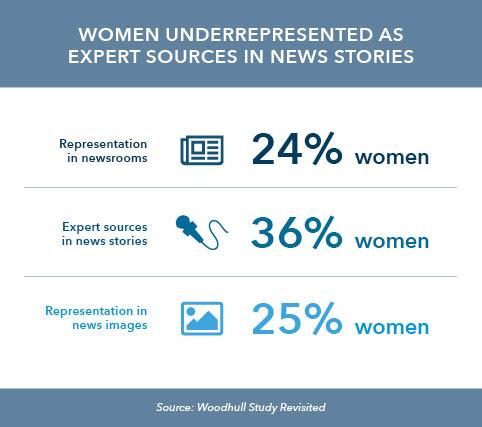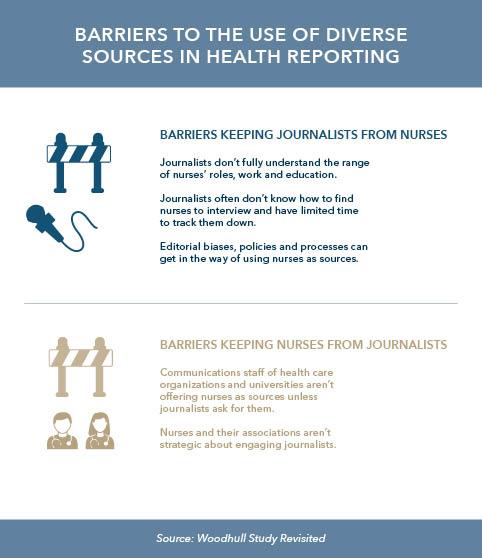The Woodhull Study Revisited
Diversity is key to good journalism in a pluralistic society — whether diversity of topics, journalists or sources. Women continue to be underrepresented in newsrooms (24 percent) and as expert sources in news stories (36 percent). Although women are included as sources in 48 percent of health news stories, the Woodhull Study on Nursing and the Media: Health Care’s Invisible Partner, published in 1998, found that nurses were identified as sources in only 4 percent of quotes or other sourcing in health news stories in leading print national and regional newspapers and 1 percent in weeklies and industry publications such as Modern Healthcare in September of 1997. Nurses were never cited in health news stories on policy and were rarely identified in photos accompanying the articles. Named after Nancy Woodhull, a founding editor of USA Today, the study raised awareness that the voices and perspectives of the nation’s largest group of health professionals — now 3.5 million, almost 90 percent of whom are women — were largely invisible even when they would have been germane to the story.
Twenty years later, are nurses used as sources more often in health news stories in print media? This three-phase study proposes to answer the following questions:
- Phase 1
Are nurses represented as sources and identified in photos in health news stories in public and trade print publications with greater frequency than in 1997?
- Phase 2
What do health journalists perceive to be the barriers and facilitators to using nurses as sources in new stories?
- Phase 3
Are schools of nursing using social media to highlight the expertise of their faculty?
Are schools of nursing using social media to highlight the expertise of their faculty?
Watch the May 8, 2018, announcement of the preliminary findings below.
Preliminary Findings
Phase 1
This phase sought to replicate the original Woodhull study as closely as possible. We used the Nexis database and Webhose, a web crawling service, to collect health care stories from the same sources that the original study used, excluding those that are no longer in print. Our final sample consisted of 537 articles from seven newspapers, three newsmagazines, and three health care industry publications published in September of 2017. We analyzed each article for topic, type of article, references to health care professionals in the article, valence of those references and gender of the professional referenced.
Phase 1 was published in the Journal of Nursing Scholarship.
Phase 2
Barriers keeping journalists from nurses:
- Journalists don’t fully understand the range of nurses’ roles, work and education.
- Journalists often don’t know how to find nurses to interview and have limited time to track them down.
- Editorial biases, policies and processes can get in the way of using nurses as sources.
Barriers keeping nurses from journalists:
- Communications staff of health care organizations and universities aren’t offering nurses as sources unless journalists ask for them.
- Nurses and their associations aren’t strategic about engaging journalists.
Phase 2 was published in the American Journal of Nursing.
Phase 3
This phase examined how schools of nursing use X, formerly known as Twitter, to position nursing faculty and researchers as experts. The most recent 3,200 tweets from the public X, formerly known as Twitter, accounts of each of 47 of the top 50 schools of nursing from September 29, 2016 through February 22, 2018 were extracted and analyzed using dominant hashtags and were coded as either inward-facing (intended to invite attention from/interaction with nurses, members of the university/school community, or attendees at a nursing conference or X, formerly known as Twitter, chat) or outward-facing (intended to invite attention from/interaction with people outside of the nursing and university/school). The follower lists of all 47 schools were also extracted and analyzed.
Meet the Research Team
- Diana Mason
Diana J. Mason, PhD, RN, FAAN — Principal investigator, Senior policy service professor for the GW Nursing Center for Health Policy and Media Engagement
- Barbara Glickstein
Barbara Glickstein, MPH, MS, RN — Co-investigator, Director of Communications and Media Projects for the GW Nursing Center for Health Policy and Media Engagement
- Laura Nixon
Laura Nixon, MPH — Senior media researcher for Berkeley Media Studies Group
- Kristi Westphaln
Kristi Westphaln, PhD, RN, CPNP-PC — Senior fellow for the GW Nursing Center for Health Policy and Media Engagement
Kristi Westphaln, PhD, RN, CPNP-PC — Senior fellow for the GW Nursing Center for Health Policy and Media Engagement
In The News
Media competencies for nurses: A Delphi study
3 reasons health care journalists should interview nurses more than they do
Nurses lack representation in media: recognize them for the leaders that they are
Speak Up: How One Nurse Turned a Chance Encounter Into a Front-Page Story
Does the media ignore nurses? A recent study suggests it does.
Where Are the Nurses in Today's Health News?
Opinion: A Nurse's Perspective
Nurses: the hidden healthcare professionals
Nurses always have known the medical value of compassion
Beyond the Food and Tchotchkes: A Challenge for Nurses Week
Learn about the Woodhull Study Revisited through this Spark presentation created by Mary Boyle.
Learn More
Nurses in the Media: A Conversation with Diana Mason
Nurses Week 2019 Webinar: 4 million nurses. 4 million voices. It's time to be heard.
In celebration of the one-year anniversary of the release of The Woodhull Study Revisited, Diana Mason presents the results of the study. This webinar discusses the specific reasons why journalists don't often use nurses as sources, why the absence of nurses' voices in health news matters to the public and the profession, and strategies that nurses, nursing organizations, nursing journals and others can use to increase nurses' representation in health news.
The Woodhull Study Revisited: Nurses' Representation in Health News Media 20 Years Later
Read more on the study's preliminary findings in the research brief and data visualizations available for download.




